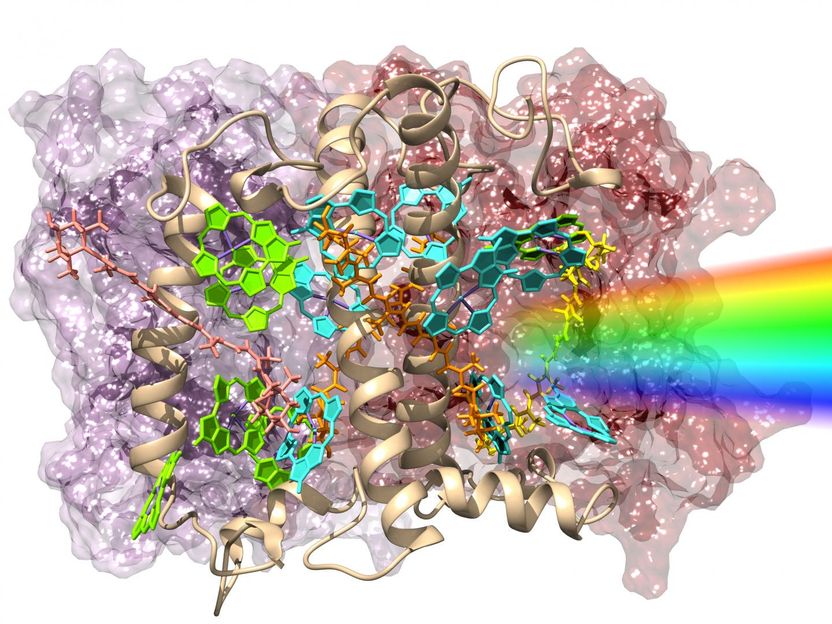Supercomputers enlisted to shed light on photosynthesis
Researchers using high-performance computing to simulate the initial processes of photosynthesis
Computing enables scientists and engineers to analyse highly complex physical processes using simulation techniques. In this case, researchers in the UPV/EHU's Department of Computer Architecture and Technology and the Department of Materials Physics are collaborating with researchers from various universities (including the Universidade de Coimbra, Universitat de Barcelona, Lawrence Livermore National Laboratory, Martin-Luther-Universität Halle-Wittenberg, University of Liege) to analyse the photosynthesis process basing themselves on various theories because the way in which plants absorb light remains a mystery.

This is the LHC-II molecule and an incident beam of light.
UPV/EHU
The molecule that carries out photosynthesis in plants is the LHC-II (Light Harvesting Complex II). Scientists do not know how this molecule acts when it receives photons of light. Complex computers and advanced programs are needed to be able to simulate molecules as big as this one. Joseba Alberdi, a UPV/EHU computer engineer, has written up his thesis in this field.
The aim: to achieve high performance
The OCTOPUS software package used to make the calculations is underpinned by two theories which are the result of the reformulation of quantum mechanics and which are based on electronic density. With these two theories it has been possible to solve quantum mechanics problems using the computer; since "otherwise what you get are equations that are so complex that they are impossible to solve even with the most powerful supercomputers", explained Alberdi. "Unfortunately, very long execution times are needed to simulate systems in their actual size, and the only alternative is to use supercomputers," he added. The aim of this thesis by the researcher Joseba Alberdi was to optimize the OCTOPUS code and to achieve high performance to be able to obtain the right acceleration factors in the calculations that are made in supercomputers. In fact, to be able to execute this code across multiple processors, it was necessary to sort out various problems affecting memory and performance. Fully executing the LHC-II molecule still poses a big challenge, but they have managed to simulate significant parts of the molecule. "We have simulated systems comprising 5,759, 4,050 and 6,075 atoms; according to the data we have available, they are the biggest simulations carried out so far," said the researcher. In these simulations they have been able to prove that the theory coincides with the reality. "These simulations will enable us to understand, for the first time, the reactions that occur during the first femtoseconds of photosynthesis", he explained. At the same time, the improvements incorporated into the application make it possible to simulate many other systems of this size, and as it also involves free software, all physicists can avail themselves of it.
Original publication
Original publication
J. Jornet-Somoza, J. Alberdi-Rodriguez, B.F. Milne, X. Andrade, M.A.L. Marques, F. Nogueira, M.J.T. Oliveira, James J. P. Stewart and A. Rubio; "Insights into colour-tuning of chlorophyll optical response in green plants"; Phys. Chem. Chem. Phys.; 2015
Topics
Organizations
Other news from the department science

Get the analytics and lab tech industry in your inbox
From now on, don't miss a thing: Our newsletter for analytics and lab technology brings you up to date every Tuesday. The latest industry news, product highlights and innovations - compact and easy to understand in your inbox. Researched by us so you don't have to.





















































